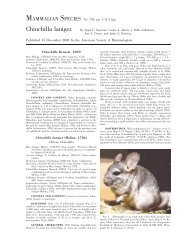Brugia Malayi - Clark Science Center - Smith College
Brugia Malayi - Clark Science Center - Smith College
Brugia Malayi - Clark Science Center - Smith College
Create successful ePaper yourself
Turn your PDF publications into a flip-book with our unique Google optimized e-Paper software.
Making the Keyboard Instrument<br />
Freda Moore<br />
As part of my research this summer, I worked mainly on the keyboard instrument (KIns) project. The goal of the project was<br />
to create a viable musical instrument that was free, open-source, simple, able to run on any computer that can run ChucK, and<br />
aimed at a user base that did not otherwise have access to physical musical instruments or formal music instruction. Throughout<br />
its development process, the KIns has provided an interesting look into the difficulties and quirks of making a computer/human<br />
music generating environment.<br />
ChucK, the language that the KIns is written in, is a strongly-timed, concurrent, and on-the-fly audio programming<br />
language, created by Ge Wang and Perry Cook. I wanted to use ChucK to create music, rather than just sounds, and after some<br />
experimentation, I decided that the best way to do this would be to create a program that could be used to naturally create music.<br />
The KIns went through a couple iterations before reaching its current, semi-finished state. It began as a simple program that<br />
mapped sounds to keys on the keyboard, and had only one type of sound. My coworker, Lucy Chikwetu, and I worked together to<br />
create an interface and a wider array of sounds for the KIns. I then worked to create a “looping” feature, in which the user could<br />
record a short sequence of keypresses which the KIns would record and then play back in a loop. This is a technique used by<br />
musicians in live performances (for example, in this video: http://www.youtube.com/watch?v=n2DHHRyt_Bw).<br />
The KIns as a whole was quite a large undertaking, and I did not manage to implement all the features that I wanted.<br />
However, because of the intended open-source nature and the code that I was careful to fully document, it is my hope that others<br />
can add onto the KIns in the future, whether for fun or for learning purposes. (Supported by the National <strong>Science</strong> Foundation)<br />
Advisor: Judy Franklin<br />
2012<br />
97

















